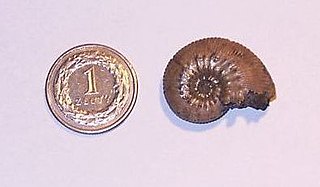Karapadites is an extinct ammonoid genus belonging to the desmoceratacean family Kossmaticeratidae and considered by some to be a subgenus of Kossmaticeras.

Ammonoceratites is an extinct genus of ammonoid cephalopod known from the Albian of British Columbia, Madagascar, New Zealand, and Japan, included in the Lytoceratidae.

Aulacostephanus is an extinct ammonoid cephalopod genus from the Upper Jurassic Tithonian belonging to the perisphinctacean family Aulacostephanidae.

Aspidoceras is an extinct ammonoid cephalopod genus belonging to the family Aspidoceratidae.

Audaxlytoceras is an extinct genus of lytoceratid ammonites.

Arnioceras is an extinct genus of large, evolute, discoidal ammonite from the Lower Jurassic. The shell is normally coiled so that all whorls are exposed. Sides bear strong sharp ribs that are straight until reaching the ventrolateral edge where they swing forward and fade. The rim (venter) is keeled and free of grooves.
Balticeras is an involute, discoidal Upper Jurassic (Oxfordian) ammonite found in England, Germany, and Switzerland, belonging to the Perisphinctidae. The shell is strongly embracing, tending to be oxyconic. Sides are gently curved, converging on a narrow to sharp ventral rim.
Balearites is an extinct ancyloceratin genus included in the family Crioceratitidae, subclass Ammonoidea, from the Upper Hauterivian.
Berniceras is an extinct ammonite genus from the order Ammonitida that lived during the early Oxfordian stage of the Late Jurassic. Berniceras is included in the ammonite family, Oppeliidae.
Benacoceras is a strongly ribbed, evolute ammonite from the Late Jurassic, coiled so that all whorls are exposed. Ribbing is biplicate, with very short secondaries. The venter, the outer rim, is smooth, at least on the outer whorl.

Kosmoceras is a moderately evolute ammonite genus from the upper Callovian of Europe with a simple apterure and irregular ribbing interrupted by an irregular row of lateral tubercles. Strong ventral tubercles are separated by a smooth depression running along the rim.

Cadomites is an extinct ammonite genus from the superfamily Stephanoceratoidea that lived during the Middle Jurassic.
Euaptetoceras is an evolute hildoceratoid ammonite from the lower Middle Jurassic, included in the family Hammatoceratidae and the subfamility Hammatoceratinae. The genus may be a junior synonym for Eudmetoceras of Buckman, 1920.
Dorsetensia is a narrowly coiled discoidal ammonite from the early Middle Jurassic, lower Bajocian, belonging to the family Sonniniidae of the superfamily Hildoceratoidea. The inner whorls are ribbed or smooth, outer whorl is smooth. The outer rim (venter) is narrow, with a keel running along the middle. The umbilicus, the opening in the middle of the shell exposing inner whorls, is of moderate size with a sharp, sometimes undercut edge.

Peltoceras is an extinct ammonite genus from the aspidoceratid subfamily Peltoceratinae that lived during the later part of the Middle Jurassic.
Crucilobiceras is an ammonoid cephalopod genus from the Lower Jurassic belonging to the eoderoceratoidean family Eoderoceratidae. Cruciliboceras has an evolute shell, such that all whorls are well exposed, with persistent radial ribbing and with spines or tubercles on the outer, ventral, rim, and in some, tubercles in the inner, umbilical, rim. The genus Crucilobiceras is commonly found along the Jurassic Coast of England.
Ptycholytoceras is a genus of fast-moving nektonic ammonoid carnivores included in the Lytoceratinae in which the shell has round inner and depressed outer whorls and sides with dorso-ventrally sloping folds that do not pass onto the venter.
Dasyceras is an early phylloceratid from the Sinemurian stage of the lower Jurassic, found in Europe.
Dayiceras is a finely ribbed polymorphitid eoderoceratacean ammonoid cephalopod from the Jurassic, named by Spath in 1920. The shell is evolute, coiled such that all whorls are exposed. The whorl section is compressed such as to be higher than wide. A row of fine tubercles runs along the middle of the outer rim, the venter.








